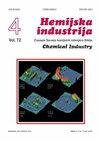加工工业用缝管。环形试样断裂分析
IF 0.8
4区 工程技术
Q4 ENGINEERING, CHEMICAL
引用次数: 5
摘要
管道通常用于过程工业中流体和颗粒状固体的运输,因为与其他运输手段相比,管道具有许多优点。管道的完整性对于整个工厂的可靠工作以及安全保证至关重要。此外,在某些情况下,管道故障可能导致严重的生态后果,即由于化学品或其他工厂中有毒、易燃或其他危险液体的泄漏。因此,研究管道的断裂行为是非常重要的,这是通过测试最近提出的环形试件暴露于弯曲。这些样品是用缝管制造的,用于压力应用(允许使用温度高达300°C)。最初的缺陷,非常窄的缺口,要么在母材和焊缝金属(接缝)上加工,要么只在母材上加工。无论缺陷位置如何,所有试样均表现出延性断裂机制。结果表明,环形试样可以成功地用于管道材料的断裂表征,特别是对于由于壁厚不足而不适合制作标准断裂力学试样的薄壁管道。本文章由计算机程序翻译,如有差异,请以英文原文为准。
Seam pipes for process industry - fracture analysis by using ring-shaped specimens
Pipelines are commonly used in process industry for transport of fluids, as well as granular solids, due to their numerous advantages in comparison to other transportation means. Pipe integrity is essential for a reliable work of the entire plant, as well as for safety assurance. Also, serious ecological consequences may follow the pipeline failure in some cases, i.e. due to the leak of toxic, flammable or otherwise dangerous fluids in a chemical or some other plant. Therefore, it is very important to examine the fracture behaviour of pipelines, which is done here by testing the recently proposed ring-shaped specimens exposed to bending. The specimens were fabricated from a seam pipe for pressure applications (allowed for usage on temperatures up to 300 °C). Initial defects, very narrow notches, were machined either in the base metal and weld metal (seam) or in the base metal only. Regardless of the defect position, ductile fracture mechanism is observed in all specimens. The results show that the ring-shaped specimen can be successfully used for fracture characterisation of pipeline material, especially for thin-walled pipes which are not suitable for production of standard fracture mechanics specimens due to the insufficient wall thickness.
求助全文
通过发布文献求助,成功后即可免费获取论文全文。
去求助
来源期刊

Hemijska Industrija
工程技术-工程:化工
CiteScore
1.60
自引率
11.10%
发文量
12
审稿时长
6-12 weeks
期刊介绍:
The Journal Hemijska industrija (abbreviation Hem. Ind.) is publishing papers in the field of Chemical Engineering (Transport phenomena; Process Modeling, Simulation and Optimization; Thermodynamics; Separation Processes; Reactor Engineering; Electrochemical Engineering; Petrochemical Engineering), Biochemical Engineering (Bioreactors; Protein Engineering; Kinetics of Bioprocesses), Engineering of Materials (Polymers; Metal materials; Non-metal materials; Biomaterials), Environmental Engineeringand Applied Chemistry. The journal is published bimonthly by the Association of Chemical Engineers of Serbia (a member of EFCE - European Federation of Chemical Engineering). In addition to professional articles of importance to industry, scientific research papers are published, not only from our country but from all over the world. It also contains topics such as business news, science and technology news, information on new apparatus and equipment, and articles on environmental protection.
 求助内容:
求助内容: 应助结果提醒方式:
应助结果提醒方式:


